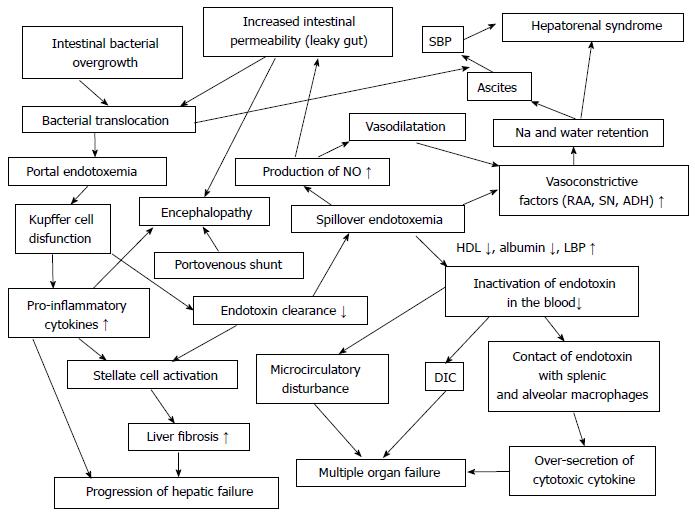Copyright
©The Author(s) 2015.
World J Hepatol. Mar 27, 2015; 7(3): 425-442
Published online Mar 27, 2015. doi: 10.4254/wjh.v7.i3.425
Published online Mar 27, 2015. doi: 10.4254/wjh.v7.i3.425
Figure 2 Mechanism of endotoxemia and its consequences in advanced liver cirrhosis (hypothesis).
Depressed elimination of endotoxin by Kupffer cells (KCs) is considered to induce spillover endotoxemia and processing of endoxin by extrahepatic macrophages which secrete larger amount of TNF than KCs. The excessive cytokine response to endotoxin by splenic and alveolar macrophages may be important in the pathogenesis of ARDS and multiple organ failure. Endotoxemia enhances vascular NO production, which is the primary stimulus for the development of vasodilatation. Enhanced vasoconstrictive factors in response to vasodilatation and endotoxemia are responsible for ascites and hepatorenal syndrome. Hepatic encephalopathy is also closely related to inflammatory reaction attributable to leaky gut amd endotoxemia. RAA: Renin-angiotensin-aldosterone system; SN: Sympathetic nerves; ADH: Antiduretic hormone (vasopressin); SBP: Spontaneous bacterial peritonitis; NO: Nitric oxide; LBP: Lipopolysaccharide binding protein; HDL: High-density lipoprotein.
- Citation: Fukui H. Gut-liver axis in liver cirrhosis: How to manage leaky gut and endotoxemia. World J Hepatol 2015; 7(3): 425-442
- URL: https://www.wjgnet.com/1948-5182/full/v7/i3/425.htm
- DOI: https://dx.doi.org/10.4254/wjh.v7.i3.425









